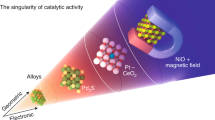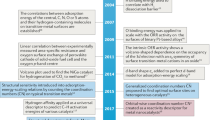Abstract
The search for improved heterogeneous catalysts is an important but difficult task. Scaling relations between the adsorption energies of reaction intermediates greatly facilitate the computational design of catalysts. However, this methodology does not currently incorporate structure sensitivity and hence cannot describe adequately the overall activity of realistic catalyst particles and extended surfaces with several facets, edges and apices. Here, we generalize scaling relations by examining twelve different low-index, stepped and kinked surfaces of nine transition metals. This allows us to quantify the effect of the adsorption-site geometry on these relations, ensures a full prediction of their parameters, and helps in identifying intrinsic thermodynamic restrictions to the performance of catalysts. The resulting fully predictable, structure-sensitive scaling relations are a step towards the long-sought rational design of multifaceted catalytic particles. Such a design can now target not only the chemical nature of active materials but also the actual geometry of their active sites.
This is a preview of subscription content, access via your institution
Access options
Subscribe to this journal
Receive 12 print issues and online access
$259.00 per year
only $21.58 per issue
Buy this article
- Purchase on Springer Link
- Instant access to full article PDF
Prices may be subject to local taxes which are calculated during checkout





Similar content being viewed by others
References
Hammer, B. & Nørskov, J. K. in Advances in Catalysis Vol. 45 (eds Bruce, C. & Gates, H. K.) 71–129 (Academic, 2000).
Van Santen, R. A. & Neurock, M. Concepts in theoretical heterogeneous catalytic reactivity. Catal. Rev. Sci. Eng. 37, 557–698 (1995).
Norskov, J. K., Bligaard, T., Rossmeisl, J. & Christensen, C. H. Towards the computational design of solid catalysts. Nature Chem. 1, 37–46 (2009).
Greeley, J., Jaramillo, T. F., Bonde, J., Chorkendorff, I. & Norskov, J. K. Computational high-throughput screening of electrocatalytic materials for hydrogen evolution. Nature Mater. 5, 909–913 (2006).
Greeley, J. & Mavrikakis, M. Alloy catalysts designed from first principles. Nature Mater. 3, 810–815 (2004).
Greeley, J. et al. Alloys of platinum and early transition metals as oxygen reduction electrocatalysts. Nature Chem. 1, 552–556 (2009).
Medford, A. J. et al. Assessing the reliability of calculated catalytic ammonia synthesis rates. Science 345, 197–200 (2014).
Abild-Pedersen, F. et al. Scaling properties of adsorption energies for hydrogen-containing molecules on transition-metal surfaces. Phys. Rev. Lett. 99, 016105 (2007).
Montemore, M. M. & Medlin, J. W. Scaling relations between adsorption energies for computational screening and design of catalysts. Catal. Sci. Technol. 4, 3748–3761 (2014).
Fu, Q., Cao, X. & Luo, Y. Identification of the scaling relations for binary noble-metal nanoparticles. J. Phys. Chem. C 117, 2849–2854 (2013).
Fernández, E. M. et al. Scaling relationships for adsorption energies on transition metal oxide, sulfide, and nitride surfaces. Angew. Chem. Int. Ed. 47, 4683–4686 (2008).
Vojvodic, A., Hellman, A., Ruberto, C. & Lundqvist, B. I. From electronic structure to catalytic activity: a single descriptor for adsorption and reactivity on transition-metal carbides. Phys. Rev. Lett. 103, 146103 (2009).
Calle-Vallejo, F., Martínez, J. I., García-Lastra, J. M., Abad, E. & Koper, M. T. M. Oxygen reduction and evolution at single-metal active sites: comparison between functionalized graphitic materials and protoporphyrins. Surf. Sci. 607, 47–53 (2013).
Calle-Vallejo, F., Martinez, J. I. & Rossmeisl, J. Density functional studies of functionalized graphitic materials with late transition metals for oxygen reduction reactions. Phys. Chem. Chem. Phys. 13, 15639–15643 (2011).
Calle-Vallejo, F., Martinez, J. I., Garcia-Lastra, J. M., Rossmeisl, J. & Koper, M. T. M. Physical and chemical nature of the scaling relations between adsorption energies of atoms on metal surfaces. Phys. Rev. Lett. 108, 116103 (2012).
Man, I. C. et al. Universality in oxygen evolution electrocatalysis on oxide surfaces. ChemCatChem 3, 1159–1165 (2011).
Calle-Vallejo, F. & Koper, M. T. M. First-principles computational electrochemistry: achievements and challenges. Electrochim. Acta 84, 3–11 (2012).
Stephens, I. E. L., Bondarenko, A. S., Gronbjerg, U., Rossmeisl, J. & Chorkendorff, I. Understanding the electrocatalysis of oxygen reduction on platinum and its alloys. Energy Environ. Sci. 5, 6744–6762 (2012).
Viswanathan, V., Hansen, H. A., Rossmeisl, J. & Nørskov, J. K. Universality in oxygen reduction electrocatalysis on metal surfaces. ACS Catal. 2, 1654–1660 (2012).
Hummelshøj, J. S., Abild-Pedersen, F., Studt, F., Bligaard, T. & Nørskov, J. K. CatApp: a web application for surface chemistry and heterogeneous catalysis. Angew. Chem. Int. Ed. 51, 272–274 (2012).
Calle-Vallejo, F. & Koper, M. T. M. Theoretical considerations on the electroreduction of CO to C2 species on Cu(100) electrodes. Angew. Chem. Int. Ed. 52, 7282–7285 (2013).
Peterson, A. A. & Nørskov, J. K. Activity descriptors for CO2 electroreduction to methane on transition-metal catalysts. J. Phys. Chem. Lett. 3, 251–258 (2012).
Nie, X., Esopi, M. R., Janik, M. J. & Asthagiri, A. Selectivity of CO2 reduction on copper electrodes: the role of the kinetics of elementary steps. Angew. Chem. Int. Ed. 52, 2459–2462 (2013).
Karp, E. M., Silbaugh, T. L. & Campbell, C. T. Bond energies of molecular fragments to metal surfaces track their bond energies to H atoms. J. Am. Chem. Soc. 136, 4137–4140 (2014).
Calle-Vallejo, F., Martínez, J. I., García-Lastra, J. M., Sautet, P. & Loffreda, D. Fast prediction of adsorption properties for platinum nanocatalysts with generalized coordination numbers. Angew. Chem. Int. Ed. 53, 8316–8319 (2014).
Peterson, A. et al. Finite-size effects in O and CO adsorption for the late transition metals. Top. Catal. 55, 1276–1282 (2012).
Mpourmpakis, G., Andriotis, A. N. & Vlachos, D. G. Identification of descriptors for the CO interaction with metal nanoparticles. Nano Lett. 10, 1041–1045 (2010).
Li, H., Li, Y., Koper, M. T. M. & Calle-Vallejo, F. Bond-making and breaking between carbon, nitrogen, and oxygen in electrocatalysis. J. Am. Chem. Soc. 136, 15694–15701 (2014).
Shustorovich, E. & Sellers, H. The UBI-QEP method: a practical theoretical approach to understanding chemistry on transition metal surfaces. Surf. Sci. Rep. 31, 1–119 (1998).
Koper, M. T. M. Thermodynamic theory of multi-electron transfer reactions: implications for electrocatalysis. J. Electroanal. Chem. 660, 254–260 (2011).
Calle-Vallejo, F. et al. Number of outer electrons as descriptor for adsorption processes on transition metals and their oxides. Chem. Sci. 4, 1245–1249 (2013).
Cheng, J. & Hu, P. Theory of the kinetics of chemical potentials in heterogeneous catalysis. Angew. Chem. Int. Ed. 50, 7650–7654 (2011).
Liu, B. & Greeley, J. Decomposition pathways of glycerol via C–H, O–H, and C–C bond scission on Pt(111): a density functional theory study. J. Phys. Chem. C 115, 19702–19709 (2011).
Salciccioli, M., Chen, Y. & Vlachos, D. G. Density functional theory-derived group additivity and linear scaling methods for prediction of oxygenate stability on metal catalysts: adsorption of open-ring alcohol and polyol dehydrogenation intermediates on Pt-based metals. J. Phys. Chem. C 114, 20155–20166 (2010).
Michalsky, R., Zhang, Y-J., Medford, A. J. & Peterson, A. A. Departures from the adsorption energy scaling relations for metal carbide catalysts. J. Phys. Chem. C 118, 13026–13034 (2014).
Siahrostami, S. et al. Enabling direct H2O2 production through rational electrocatalyst design. Nature Mater. 12, 1137–1143 (2013).
Hansen, H. A., Varley, J. B., Peterson, A. A. & Nørskov, J. K. Understanding trends in the electrocatalytic activity of metals and enzymes for CO2 reduction to CO. J. Phys. Chem. Lett. 4, 388–392 (2013).
Halck, N. B., Petrykin, V., Krtil, P. & Rossmeisl, J. Beyond the volcano limitations in electrocatalysis—oxygen evolution reaction. Phys. Chem. Chem. Phys. 16, 13682–13688 (2014).
Adić, R. R., Marković, N. M. & Vešović, V. B. Structural effects in electrocatalysis: oxygen reduction on the Au (100) single crystal electrode. J. Electroanal. Chem. Interfacial Electrochem. 165, 105–120 (1984).
Adžić, R. R., Strbac, S. & Anastasijević, N. Electrocatalysis of oxygen on single crystal gold electrodes. Mater. Chem. Phys. 22, 349–375 (1989).
Gattrell, M., Gupta, N. & Co, A. A review of the aqueous electrochemical reduction of CO2 to hydrocarbons at copper. J. Electroanal. Chem. 594, 1–19 (2006).
Hori, Y., Takahashi, I., Koga, O. & Hoshi, N. Selective formation of C2 compounds from electrochemical reduction of CO2 at a series of copper single crystal electrodes. J. Phys. Chem. B 106, 15–17 (2001).
Li, H. et al. Why (100) terraces break and make bonds: oxidation of dimethyl ether on platinum single-crystal electrodes. J. Am. Chem. Soc. 135, 14329–14338 (2013).
Vidal-Iglesias, F. J., García-Aráez, N., Montiel, V., Feliu, J. M. & Aldaz, A. Selective electrocatalysis of ammonia oxidation on Pt(100) sites in alkaline medium. Electrochem. Commun. 5, 22–26 (2003).
Vidal-Iglesias, F. J., Solla-Gullón, J., Montiel, V., Feliu, J. M. & Aldaz, A. Ammonia selective oxidation on Pt(100) sites in an alkaline medium. J. Phys. Chem. B 109, 12914–12919 (2005).
Norskov, J. K. et al. The nature of the active site in heterogeneous metal catalysis. Chem. Soc. Rev. 37, 2163–2171 (2008).
Kurth, S., Perdew, J. P. & Blaha, P. Molecular and solid-state tests of density functional approximations: LSD, GGAs, and meta-GGAs. Int. J. Quantum Chem. 75, 889–909 (1999).
Jones, G., Studt, F., Abild-Pedersen, F., Nørskov, J. K. & Bligaard, T. Scaling relationships for adsorption energies of C2 hydrocarbons on transition metal surfaces. Chem. Eng. Sci. 66, 6318–6323 (2011).
Wang, S. et al. Universal transition state scaling relations for (de)hydrogenation over transition metals. Phys. Chem. Chem. Phys. 13, 20760–20765 (2011).
Kresse, G. & Furthmüller, J. Efficient iterative schemes for ab initio total-energy calculations using a plane-wave basis set. Phys. Rev. B 54, 11169–11186 (1996).
Perdew, J. P., Burke, K. & Ernzerhof, M. Generalized gradient approximation made simple. Phys. Rev. Lett. 78, 1396–1396 (1997).
Kresse, G. & Joubert, D. From ultrasoft pseudopotentials to the projector augmented-wave method. Phys. Rev. B 59, 1758–1775 (1999).
Methfessel, M. & Paxton, A. T. High-precision sampling for Brillouin-zone integration in metals. Phys. Rev. B 40, 3616–3621 (1989).
Acknowledgements
The authors acknowledge funding from the EU, grant n°303419 (PUMA MIND). The authors thank NCF, IDRIS, CINES and PSMN for CPU time and assistance. The authors thank A. Bandarenka and J.M. García-Lastra for critical reading of this article.
Author information
Authors and Affiliations
Contributions
F.C-V. made all of the DFT calculations. All authors participated in the discussion of the results and the writing of the manuscript.
Corresponding authors
Ethics declarations
Competing interests
The authors declare no competing financial interests.
Supplementary information
Supplementary information
Supplementary information (PDF 507 kb)
Rights and permissions
About this article
Cite this article
Calle-Vallejo, F., Loffreda, D., Koper, M. et al. Introducing structural sensitivity into adsorption–energy scaling relations by means of coordination numbers. Nature Chem 7, 403–410 (2015). https://doi.org/10.1038/nchem.2226
Received:
Accepted:
Published:
Issue Date:
DOI: https://doi.org/10.1038/nchem.2226
This article is cited by
-
Unusual Sabatier principle on high entropy alloy catalysts for hydrogen evolution reactions
Nature Communications (2024)
-
Dynamic evolution of the active center driven by hemilabile coordination in Cu/CeO2 single-atom catalyst
Nature Communications (2023)
-
Plasmon-mediated chemical reactions
Nature Reviews Methods Primers (2023)
-
Multiple reaction pathway on alkaline earth imide supported catalysts for efficient ammonia synthesis
Nature Communications (2023)
-
Machine-learning-assisted design of a binary descriptor to decipher electronic and structural effects on sulfur reduction kinetics
Nature Catalysis (2023)



